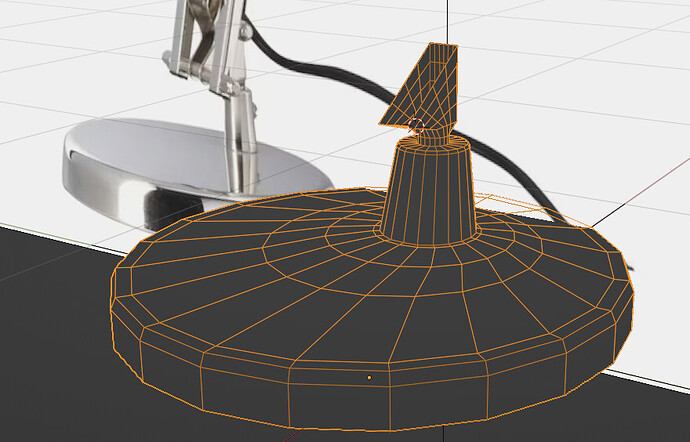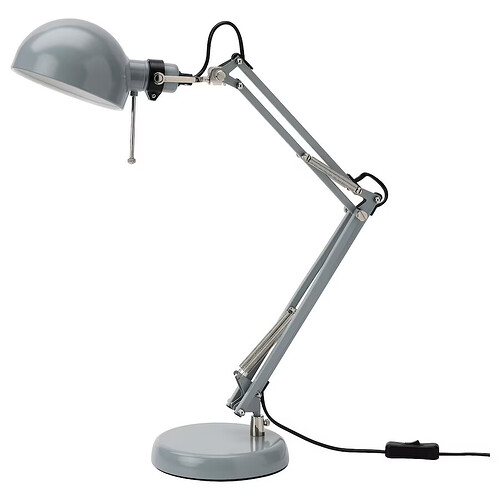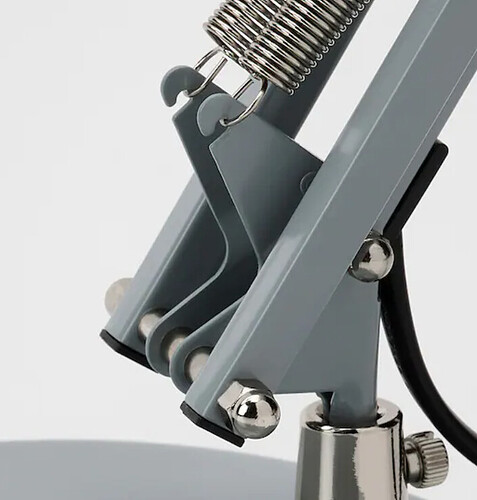This is about as far as I’ve gotten and I’m sure I must be making it harder than it needs to be…
Thanks in advance for any suggestions!
i’d model it in seperate parts, like if it were completely disassembled. if i didn’t have that particular lamp on hand, i have enough other goosenecks around that i’d use as the base, just tweaking some dimensions to get the lamp.
once you look at it in parts, you’ll see the individual parts are actually fairly simple models.
I would first collect all the info about it. It seems its dimensions are:
Height: 14 "
Base diameter: 6 "
Shade diameter: 5 "
So that’s around 35.5cm height, and base and shade diameters are 15cm and 13cm in SI units. This is very helpful information combined with all those good photos… or more likely visualisations, because I think Ikea does 3d visualisations for most of their products. No idea, why they don’t share the 3d models… Anyway, I would find the straightest image like this one:
and I would import it as a plane with the Import Images as Planes add-on, scale it according some known dimension(I have even made an add-on for myself for just that) like the diameter of the base so I could measure approximate dimensions of other parts and then I would model each separate part separately as they are in reality like Kelly Lynch suggests. It’s better to work with real dimensions, than lining everything up with an image because people usually round up the dimensions of parts to nicer numbers so a bit of guessing may leave you to more accurate results. I would be looking at all the images of the product all the time while modelling so I don’t get lost with the detail(using something like PureRef ). You have way better images than the one in your screenshots. For example you can see the forms and separate parts way better in this one than what you seem to use in the screenshot:
It’s a mistake not to use them. You cannot model something if you do not know how it looks. Reference information is extremely important and I think it’s one of the main things that separate a beginner modeller from a pro - the amount of reference information they use. Why would I guess, if I can know for sure how it looks?.. Else than that all the parts are pretty basic forms so there is nothing too difficult, just time consuming. So I would be prepared to spend some time. It would not be practical to advise in more detail without writing a book, because there are so many parts and they require many different modelling techniques. Maybe you could try modelling the parts separately and then if you struggle with something specifically, you could ask about that specifically.
Definitely, then rig it!
Oh, I remembered an excellent rigged pixar lamp that @john_9998 user had shared many years ago and surprisingly the file is still available:
More surprising is that it has not yet lost much compatibility with Blender 3.6, which cannot be ensured with Blender 4 because this will break some compatibilities.
So, you use it as an example.
I just opened it in 4.0 and it is fine (with working rig).
Reminds me of this conversation:
Edit:
You can not append objects but you can open files.
I am not sure what I did wrong the first time but I can append objects as well.
Oh, okay. Good to know ![]()
thanks for replying that’s a useful suggestion
ooooo epic thanks!
![]() !!!
!!!





